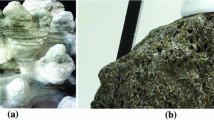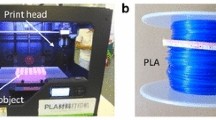Abstract
Three-dimensional printing (3DP) is a computer-controlled additive manufacturing technique which is able to repeatedly and accurately fabricate objects with complicated geometry and internal structures. After 30 years of fast development, 3DP has become a mainstream manufacturing process in various fields. This study focuses on identifying the most suitable 3DP material from five targeted available 3DP materials, i.e. ceramics, gypsum, PMMA (poly(methyl methacrylate)), SR20 (acrylic copolymer) and resin (Accura® 60), to simulate brittle and hard rocks. Firstly, uniaxial compression tests were performed to determine the mechanical properties and failure patterns of the 3DP samples fabricated by those five materials. Experimental results indicate that among current 3DP techniques, the resin produced via stereolithography (SLA) is the most suitable 3DP material for mimicking brittle and hard rocks, although its brittleness needs to be improved. Subsequently, three methods including freezing, incorporation of internal macro-crack and addition of micro-defects were adopted to enhance the brittleness of the 3DP resin, followed by uniaxial compression tests on the treated samples. Experimental results reveal that 3DP resin samples with the suggested treatments exhibited brittle properties and behaved similarly to natural rocks. Finally, some prospective improvements which can be used to facilitate the application of 3DP techniques to rock mechanics were also discussed. The findings of this paper could contribute to promoting the application of 3DP technique in rock mechanics.












Similar content being viewed by others
References
Alber M, Fritschen R, Bischoff M, Meier T (2009) Rock mechanical investigations of seismic events in a deep longwall coal mine. Int J Rock Mech Min Sci 46(2):408–420
Anthony S (2014) SpaceX rocket carries the first ever zero-g 3D printer to the space station. http://www.extremetech.com/extreme/190629-spacex-rocket-launches-to-the-space-station-carrying-the-first-ever-zero-g-3d-printer. Accessed 26 Apr 2015
ASTM D638 (2010) Standard test method for tensile properties of plastics. ASTM International, West Conshohocken, p 2010
Belter JT, Dollar AM (2015) Strengthening of 3D printed fused deposition manufactured parts using the fill compositing technique. PLoS ONE 10(4):e0122915
Cai M (2010) Practical estimates of tensile strength and Hoek–Brown strength parameter mi of brittle rocks. Rock Mech Rock Eng 43(2):167–184
Capel AJ, Edmondson S, Christie SD, Goodridge RD, Bibb RJ, Thurstans M (2013) Design and additive manufacture for flow chemistry. Lab Chip 13(23):4583–4590
Chia HN, Wu BM (2015) Recent advances in 3D printing of biomaterials. J Biol Eng 9(1):4
Dal Ferro N, Morari F (2015) From real soils to 3D-printed soils: reproduction of complex pore network at the real size in a silty-loam soil. Soil Sci Soc Am J 79(4):1008–1017
Eberhardt E, Stead D, Stimpson B (1999) Quantifying progressive pre-peak brittle fracture damage in rock during uniaxial compression. Int J Rock Mech Min Sci 36(3):361–380
Feng P, Meng X, Chen JF, Ye L (2015) Mechanical properties of structures 3D printed with cementitious powders. Constr Build Mater 93:486–497
Fereshtenejad S, Song JJ (2016) Fundamental study on applicability of powder-based 3D printer for physical modeling in rock mechanics. Rock Mech Rock Eng 49(6):2065–2074
Fredrich JT, Evans B, Wong TF (1990) Effect of grain size on brittle and semibrittle strength: implications for micromechanical modelling of failure in compression. J Geophys Res 95(B7):10907–10920
Ganter M, Storti D, Utela B (2009) The printed pot. Ceram Mon 56:36–39
Griffith WA, Rosakis A, Pollard DD, Ko CW (2009) Dynamic rupture experiments elucidate tensile crack development during propagating earthquake ruptures. Geology 37:795–798
Hart KR, Wetzel ED (2017) Fracture behaviors of additively manufactured acrylonitrile butadiene styrene (ABS) materials. Eng Fract Mech. https://doi.org/10.1016/j.engfracmech.2017.03.028
Hiller J, Lipson H (2009) Design and analysis of digital materials for physical 3D voxel printing. Rapid Prototyp J 15(2):137–149
Huang SH, Liu P, Mokasdar A, Hou L (2013a) Additive manufacturing and its societal impact: a literature review. Int J Adv Manuf Technol 67(5):1191–1203
Huang S, Xia K, Zheng H (2013b) Observation of microscopic damage accumulation in brittle solids subjected to dynamic compressive loading. Rev Sci Instrum 84(9):093903
Huang L, Stewart RR, Dyaur N, Baez-Franceschi J (2016) 3D-printed rock models: elastic properties and the effects of penny-shaped inclusions with fluid substitution. Geophysics 81(6):669–677
Ishutov S, Hasiuk FJ, Harding C, Gray JN (2015) 3D printing sandstone porosity models. Interpretation 3(3):SX49–SX61
Jiang C, Zhao GF (2015) A preliminary study of 3D printing on rock mechanics. Rock Mech Rock Eng 48(3):1041–1050
Jiang Q, Feng XT, Gong YH, Song LB, Ran SG, Cui J (2016) Reverse modelling of natural rock joints using 3D scanning and 3D printing. Comput Geotech 73:210–220
Ju Y, Xie H, Zheng Z, Lu J, Mao L, Gao F et al (2014) Visualization of the complex structure and stress field inside rock by means of 3D printing technology. Chin Sci Bull 59(36):5354–5365
Ju Y, Wang L, Xie H, Ma G, Zheng Z, Mao L (2017) Visualization and transparentization of the structure and stress field of aggregated geomaterials through 3D printing and photoelastic techniques. Rock Mech Rock Eng 50(6):1383–1407
Karaca M, Egger P (1993) Failure phenomena around shallow tunnels in jointed rock. In: Proceedings of the International Symposium on Assessment and Prevention of Failure Phenomena in Rock Engineering, Istanbul, Turkey, pp 381–388
Kawakata H, Cho A, Kiyama T, Yanagidani T, Kusunose K, Shimada M (1999) Three-dimensional observations of faulting process in Westerly granite under uniaxial and triaxial conditions by X-ray CT scan. Tectonophysics 313(3):293–305
Kokkinis D, Schaffner M, Studart AR (2015) Multimaterial magnetically assisted 3D printing of composite materials. Nat Commun 6:8643
Liu J, Liu FH, Kong XJ, Yu L (2014) Large-scale shaking table model tests of aseismic measures for concrete faced rock-fill dams. Soil Dyn Earthq Eng 61–62(3):152–163
Lockner D, Byerlee J, Kuksenko V, Ponomarev A, Sidorin A (1991) Quasi-static fault growth and shear fracture energy in granite. Nature 350(6313):39–42
Marks P (2011) 3D printing takes off with the world’s first printed plane. New Sci 211(2823):17–18
Michna S, Wu W, Lewis JA (2005) Concentrated hydroxyapatite inks for direct-write assembly of 3-D periodic scaffolds. Biomaterials 26(28):5632–5639
Mitchell MG (2016) Cell biology: translational impact in cancer biology and bioinformatics. Elsevier, Cambridge, p 122
Munz D, Fett T (1999) Ceramics: mechanical properties, failure behaviour, materials selection. Springer, NewYork, p 1
NASA (2014) Space station 3-D printer builds ratchet wrench to complete first phase of operations. http://www.nasa.gov/mission_pages/station/research/news/3Dratchet_wrench. Accessed 26 Apr 2015
Otten W, Pajor R, Schmidt S, Baveye PC, Hague R, Falconer RE (2012) Combining X-ray CT and 3D printing technology to produce microcosms with replicable, complex pore geometries. Soil Biol Biochem 51:53–55
Richeton J, Ahzi S, Vecchio KS, Jiang FC, Adharapurapu RR (2006) Influence of temperature and strain rate on the mechanical behavior of three amorphous polymers: characterization and modeling of the compressive yield stress. Int J Solids Struct 43(7):2318–2335
Roylance D (2001) Introduction to fracture mechanics. Massachusetts Institute of Technology, Cambridge, p 1
Saba N, Jawaid M, Alothman OY, Paridah MT (2016) A review on dynamic mechanical properties of natural fibre reinforced polymer composites. Constr Build Mater 106:149–159
Sammis CG, Rosakis AJ, Bhat HS (2009) Effects of off-fault damage on earthquake rupture propagation: experimental studies. Pure appl Geophys 166:1629–1648
Seweryn A, Poskrobko S, Mróz Z (1997) Brittle fracture in plane elements with sharp notches under mixed-mode loading. J Eng Mech 123(6):535–543
Tang CA, Kaiser PK (1998) Numerical simulation of cumulative damage and seismic energy release during brittle rock failure-part I: fundamentals. Int J Rock Mech Min Sci 35(2):113–121
Vaitkus A, Gražulyt J, Kleizien R (2014) Influence of static and impact load on pavement performance. In: The 9th international conference on environmental engineering, Vilnius, Lithuania, pp 1–9
Wawersik WR, Fairhurst C (1970) A study of brittle rock fracture in laboratory compression experiments. Int J Rock Mech Min Sci 7(5):561–575
Wong NY (2008) Crack coalescence in molded gypsum and Carrara marble. Ph.D. thesis, Massachusetts Institute of Technology, Cambridge, MA, p 35
Wong TF, David C, Zhu W (1997) The transition from brittle faulting to cataclastic flow in porous sandstones: mechanical deformation. J Geophys Res 102(B2):3009–3025
Wu Y, McGarry FJ, Zhu B, Keryk JR, Katsoulis DE (2005) Temperature effect on mechanical properties of toughened silicone resins. Polym Eng Sci 45(11):1522–1531
Wu C, Luo Y, Cuniberti G, Xiao Y, Gelinsky M (2011) Three-dimensional printing of hierarchical and tough mesoporous bioactive glass scaffolds with a controllable pore architecture, excellent mechanical strength and mineralization ability. Acta Biomater 7(6):2644–2650
Wu C, Fan W, Zhou Y, Luo Y, Gelinsky M, Chang J et al (2012) 3D-printing of highly uniform CaSiO 3 ceramic scaffolds: preparation, characterization and in vivo osteogenesis. J Mater Chem 22(24):12288–12295
Zhu JB, Zhou T, Liao ZY, Sun L, Li XB, Chen R (unpublished manuscript) Replication of internal defects and investigation of mechanical and fracture behaviours of rocks using 3D printing and 3D numerical methods with combination of X-ray computerized tomography. Submitted to Geophys J Int
Yan X, Gu PENG (1996) A review of rapid prototyping technologies and systems. Comput Aided Des 28(4):307–318
Zhou T, Zhu JB (2017) An experimental investigation of tensile fracturing behavior of natural and artificial rocks in static and dynamic Brazilian disc tests. Procedia Eng 191:992–998. The 2017 ISRM European Rock Mechanics Symposium, Ostrava, Czech
Acknowledgements
We thank W. F. Wong, S. K. Yik and C. M. Wong from Industrial Centre of the Hong Kong Polytechnic University for their support in 3DP sample preparation. We are grateful to K. M. Leung from Rock Mechanics Laboratory of the Hong Kong Polytechnic University and R. Chen at National University of Defense Technology for their support in performing laboratory tests. A portion of this paper was reported in a conference paper (Zhou and Zhu 2017). This research was financially supported by the Hong Kong Research Grant Council (No. 25201814) and the National Natural Science Foundation of China (No. 41402241).
Author information
Authors and Affiliations
Corresponding author
Rights and permissions
About this article
Cite this article
Zhou, T., Zhu, J.B. Identification of a Suitable 3D Printing Material for Mimicking Brittle and Hard Rocks and Its Brittleness Enhancements. Rock Mech Rock Eng 51, 765–777 (2018). https://doi.org/10.1007/s00603-017-1335-7
Received:
Accepted:
Published:
Issue Date:
DOI: https://doi.org/10.1007/s00603-017-1335-7




